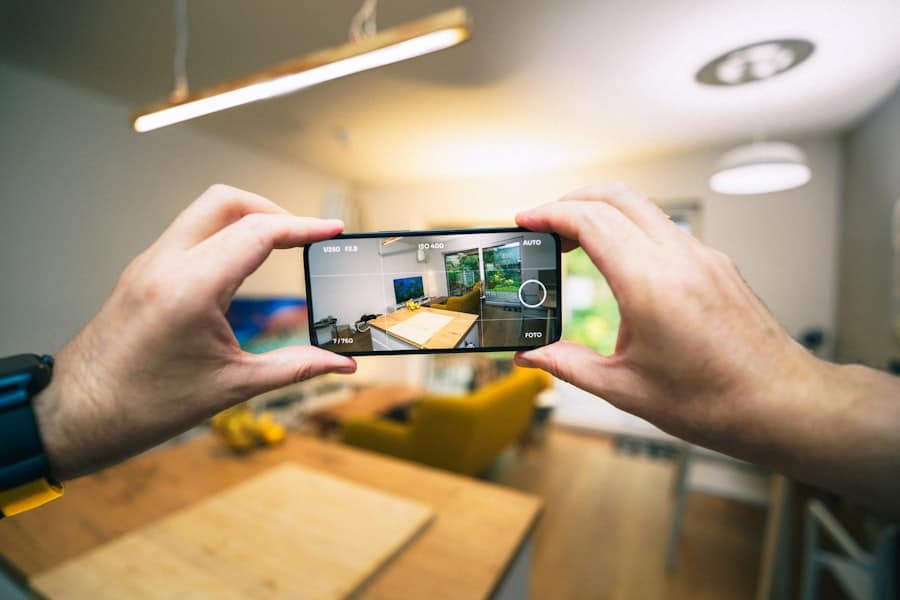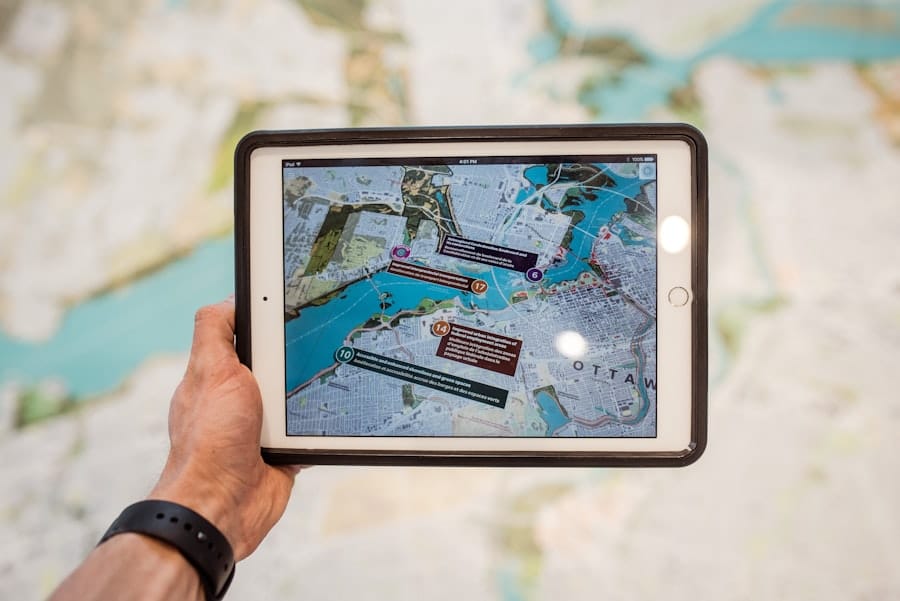Augmented Reality (AR) is a technology that overlays digital information—such as images, sounds, and other sensory enhancements—onto the real world, thereby enriching the user’s perception of their environment. Unlike Virtual Reality (VR), which immerses users in a completely digital environment, AR enhances the real world by adding layers of digital content that can be interacted with in real-time. This technology utilizes devices such as smartphones, tablets, and specialized AR glasses to create an interactive experience that blends the physical and digital realms seamlessly.
The core principle of AR lies in its ability to recognize and interpret the physical environment through sensors and cameras. By employing computer vision, simultaneous localization and mapping (SLAM), and depth tracking, AR systems can identify surfaces, objects, and even people within a space. This capability allows for the precise placement of digital elements in relation to the physical world, enabling users to engage with these elements as if they were part of their actual surroundings.
As a result, AR has found applications across various fields, including education, healthcare, retail, and manufacturing, transforming how tasks are visualized and executed.
Key Takeaways
- Augmented Reality (AR) is a technology that overlays digital information onto the real world, enhancing the user’s perception of their environment.
- Using AR for task visualization can improve efficiency, accuracy, and safety by providing real-time guidance and information to users.
- Examples of AR in task visualization include assembly instructions, maintenance procedures, and medical training simulations.
- Implementing AR for task visualization requires selecting the right hardware, developing user-friendly interfaces, and integrating with existing systems.
- Challenges of AR for task visualization include cost, technical limitations, and potential user resistance, but best practices can help mitigate these issues and maximize the benefits of the technology.
Benefits of Using Augmented Reality for Task Visualization
The integration of Augmented Reality into task visualization offers numerous advantages that enhance productivity and efficiency.
For instance, when technicians are repairing machinery, AR can display step-by-step instructions or highlight specific components that need attention.
This immediate access to relevant data minimizes the time spent searching for manuals or instructions, allowing workers to focus on completing their tasks more effectively. Moreover, AR facilitates improved collaboration among team members, especially in remote settings.
For example, a remote expert can guide a technician on-site by overlaying visual cues on the equipment being serviced. This not only enhances communication but also reduces the need for travel and minimizes downtime associated with waiting for expert assistance. The ability to visualize tasks collaboratively fosters a more cohesive work environment and accelerates project timelines.
Examples of Augmented Reality in Task Visualization
Numerous industries have begun to harness the power of Augmented Reality for task visualization, showcasing its versatility and effectiveness. In the manufacturing sector, companies like Boeing have implemented AR to streamline assembly processes. Technicians use AR glasses that project 3D models of aircraft components directly onto their workstations.
This visualization allows them to see how parts fit together before physically assembling them, reducing errors and improving overall efficiency. The use of AR in this context not only speeds up production but also enhances quality control by ensuring that each component is correctly placed. In the realm of healthcare, AR is revolutionizing surgical procedures through enhanced visualization techniques.
Surgeons can utilize AR systems that overlay critical information—such as patient anatomy or vital signs—onto their field of view during operations. For instance, during a complex surgery, an AR application might highlight blood vessels or organs that need to be avoided, providing surgeons with real-time guidance that enhances precision and safety. This application of AR not only improves surgical outcomes but also serves as a valuable training tool for medical students who can practice procedures in a simulated environment enriched with real-time data.
How to Implement Augmented Reality for Task Visualization
Implementing Augmented Reality for task visualization requires careful planning and consideration of various factors to ensure successful integration into existing workflows. The first step involves identifying specific tasks or processes that would benefit from AR enhancements. Organizations should conduct a thorough analysis of their operations to pinpoint areas where AR can provide significant value—be it through improved training, enhanced maintenance procedures, or streamlined assembly lines.
Once potential applications are identified, organizations must select appropriate AR technologies and platforms that align with their needs. This may involve choosing between mobile-based AR applications or more sophisticated head-mounted displays (HMDs) depending on the complexity of tasks and user requirements. Additionally, developing high-quality 3D models and interactive content is crucial for effective task visualization.
Collaborating with skilled developers and designers can help create engaging AR experiences that resonate with users and facilitate learning. Training employees on how to effectively use AR tools is another critical aspect of implementation. Providing comprehensive training sessions ensures that users are comfortable navigating the technology and can fully leverage its capabilities during their tasks.
Furthermore, organizations should establish feedback mechanisms to gather insights from users about their experiences with AR applications. Continuous improvement based on user feedback will help refine the technology’s effectiveness and enhance overall satisfaction.
Challenges and Limitations of Augmented Reality for Task Visualization
Despite its numerous advantages, the adoption of Augmented Reality for task visualization is not without challenges and limitations. One significant hurdle is the technological barrier associated with implementing AR solutions. Organizations may face difficulties in integrating AR systems with existing infrastructure or may require substantial investments in hardware and software development.
Additionally, ensuring compatibility across various devices can complicate deployment efforts. Another challenge lies in user acceptance and adaptability. Employees may be resistant to adopting new technologies due to concerns about usability or fear of job displacement.
It is essential for organizations to address these concerns through effective change management strategies that emphasize the benefits of AR while providing adequate support during the transition period. Moreover, ensuring that AR applications are intuitive and user-friendly is crucial for fostering acceptance among employees. Data privacy and security also pose significant challenges when implementing AR solutions.
As AR systems often rely on collecting and processing real-time data from users’ environments, organizations must prioritize safeguarding sensitive information against potential breaches. Establishing robust security protocols and ensuring compliance with data protection regulations are essential steps in mitigating these risks.
Best Practices for Using Augmented Reality for Task Visualization
To maximize the benefits of Augmented Reality for task visualization, organizations should adhere to several best practices that enhance user experience and effectiveness. First and foremost, it is vital to focus on user-centered design principles when developing AR applications. Engaging end-users during the design process ensures that the final product meets their needs and preferences while providing an intuitive interface that facilitates easy navigation.
Additionally, organizations should prioritize content quality by investing in high-resolution 3D models and interactive elements that enhance engagement. The clarity and accuracy of visualizations play a crucial role in ensuring users can effectively understand and execute tasks without confusion. Regularly updating content based on user feedback will also help maintain relevance and improve overall satisfaction.
Furthermore, organizations should consider implementing pilot programs before full-scale deployment of AR solutions. Testing applications in controlled environments allows organizations to identify potential issues early on and make necessary adjustments based on user experiences. Gathering feedback during these pilot phases can provide valuable insights into how well the technology meets its intended goals.
Future Trends in Augmented Reality for Task Visualization
As technology continues to evolve, several trends are emerging within the realm of Augmented Reality that will shape its future applications in task visualization. One notable trend is the increasing integration of Artificial Intelligence (AI) with AR systems. AI algorithms can enhance AR experiences by providing contextual information based on user behavior or environmental factors.
For instance, AI could analyze a technician’s actions during maintenance tasks and offer personalized suggestions or improvements based on historical data. Another trend is the growing emphasis on collaborative AR experiences facilitated by cloud computing technologies. As organizations adopt cloud-based platforms for AR applications, remote teams will be able to collaborate more effectively by sharing real-time visualizations regardless of their physical locations.
This shift will enable more dynamic interactions among team members and foster innovation through collective problem-solving. Moreover, advancements in hardware technology will likely lead to more lightweight and comfortable AR devices that enhance user experience. As manufacturers develop more sophisticated headsets with improved battery life and display quality, users will be able to engage with AR applications for extended periods without discomfort or fatigue.
This evolution will further drive adoption across various industries as organizations seek efficient solutions for task visualization.
The Impact of Augmented Reality on Task Visualization
The impact of Augmented Reality on task visualization is profound, offering transformative benefits across multiple sectors by enhancing efficiency, collaboration, and accuracy in executing tasks. As organizations continue to explore innovative ways to integrate this technology into their workflows, they will unlock new opportunities for growth and improvement. By addressing challenges related to implementation and user acceptance while adhering to best practices, businesses can harness the full potential of AR to revolutionize how tasks are visualized and executed in an increasingly complex world.
The future promises even greater advancements as technology evolves, paving the way for more immersive and effective task visualization solutions that will redefine industry standards.
If you are interested in using augmented reality for home remodeling projects, you may also want to check out this article on the best free software for home remodeling. This article provides valuable information on tools and resources that can help you visualize and plan your home renovation projects effectively. By combining the use of augmented reality with these software options, you can enhance your remodeling experience and achieve better results.
FAQs
What is augmented reality (AR)?
Augmented reality (AR) is a technology that superimposes digital information such as images, videos, or 3D models onto the real world, typically viewed through a device such as a smartphone or AR glasses.
How is augmented reality used for task visualization?
Augmented reality can be used for task visualization by overlaying digital instructions, diagrams, or other visual aids onto the real-world environment where the task is being performed. This can help users better understand and complete complex tasks by providing real-time guidance and visual cues.
What are the benefits of using augmented reality for task visualization?
Some benefits of using augmented reality for task visualization include improved efficiency, reduced errors, enhanced training experiences, and the ability to provide remote assistance. AR can also help with complex tasks that require precise spatial understanding or involve interacting with physical objects.
What are some examples of using augmented reality for task visualization?
Examples of using augmented reality for task visualization include assembly and maintenance instructions for complex machinery, medical training simulations, architectural and engineering design visualization, and interactive educational experiences.
What are the challenges of using augmented reality for task visualization?
Challenges of using augmented reality for task visualization include the need for accurate spatial mapping, potential technical limitations of AR hardware, and the development of user-friendly interfaces and content creation tools. Additionally, ensuring the privacy and security of AR data is an important consideration.



